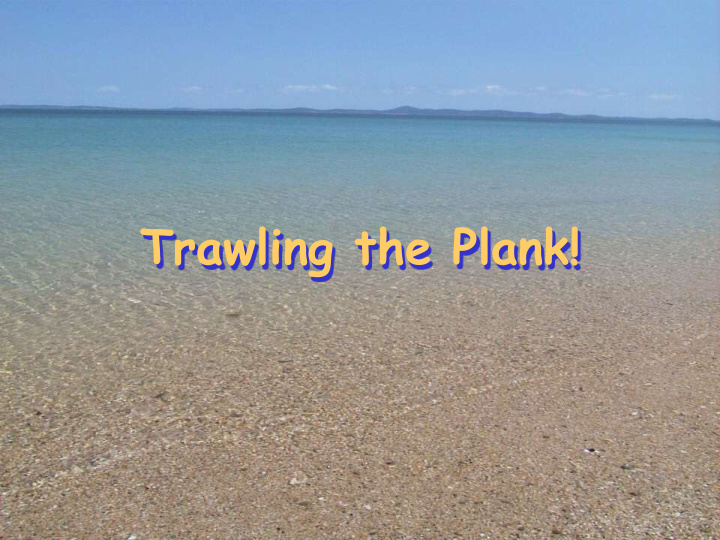



Trawling the Plank!
What is plankton ? Plankton are organisms that drift in the ocean because they either do not swim or are too small to resist ocean currents.
There are two types of plankton Plant plankton = Phytoplankton – Need sunlight + nutrients – Make sugar + O 2 – Producers Animal plankton = Zooplankton – First order consumers
Where does plankton live? • Plant plankton move with the currents, remaining in the top few metres of water • Animal plankton are free swimming, hiding in the day and feeding at night
Think about it! • Why do you think plankton are almost transparent?
Who are plankton? Some big animals start life as plankton… • Many larger animals are plankton when they are young • The plankton may be baby starfish, jellyfish or shrimps http://www.livingclassrooms.org/lbo/plankton/index.html
They’re called -Meroplankton • Meroplankton spend only the larval or early stages of their life as part of the plankton and spend their adult lives on the reef. • Many well-known animals found on the Great Barrier Reef spend time as free-swimming meroplankton, bearing little or no resemblance to the adult they will become. • Meroplankton includes sea urchins, starfish, sea squirts, most of the sea snails and slugs, crabs, lobsters, octopus, marine worms and most reef fishes.
Examples of Meroplankton 1. Tube Anemone Larvae Adult
2. Sea cucumber Larvae Adult
3. Sea star (starfish) Larvae Adult
Crustaceans display some of the most spectacular metamorphoses from free-swimming meroplankton to reef-dwelling adult. Slipper Lobster Slipper Lobster larva larva Slipper lobster adult
Holoplankton • Holoplankton • Holoplankton spend their entire lives as plankton. • This group includes krill, copepods, various pelagic (free swimming) sea snails and slugs, jellyfish and a small number of the marine worms.
Holoplankton Example 1.Diatoms
The food chain • All creatures, including people, are dependent on plankton • Phytoplankton are the beginning of the food chain • Zooplankton eat phytoplankton, which provide food for larger creatures
Example of a food chain
Carnivores O Tertiary consumers R Humans D E R D O E F C O Omnivores, carnivores or C M herbivores O P Secondary consumers N O Fish S S U E M R P S T I O Herbivores N Primary consumers Zoo Plankton Producers PhytoPlankton Sun’s energy
Plankton Trawling • Shorts • NO shoes • Workbook + pencil can go to the dry lab • Listen carefully !
Setting the net • Find a spot where you can see • Listen carefully • Watch the process
Trawling • Move carefully around the boat. • Try spotlighting marine life in the water. • Enjoy the lights of Yeppoon. • Watch for turtles, stingrays, squid and fish
Retrieve net • The teacher will retrieve the net • Inspect for jellyfish • Bring the net aboard
Bio-luminescent • Light made by life • Lights out ! • Rub the net • What do you see? • Why? • How?
Pour it in • Pour the catch into your specimen container • Look after your sample • Don’t shake or drop • Live animals !! • What can you see?
Getting off • Wait for instructions • Hold the sample jar carefully • Watch your step • Wait at the light for your teacher
Back to the Dry lab • To see your catch you will need to listen carefully • Tip off excess water • Place sample into Petri dish
See your catch • Take turns • Share your discoveries • What can you identify ?
Recommend
More recommend